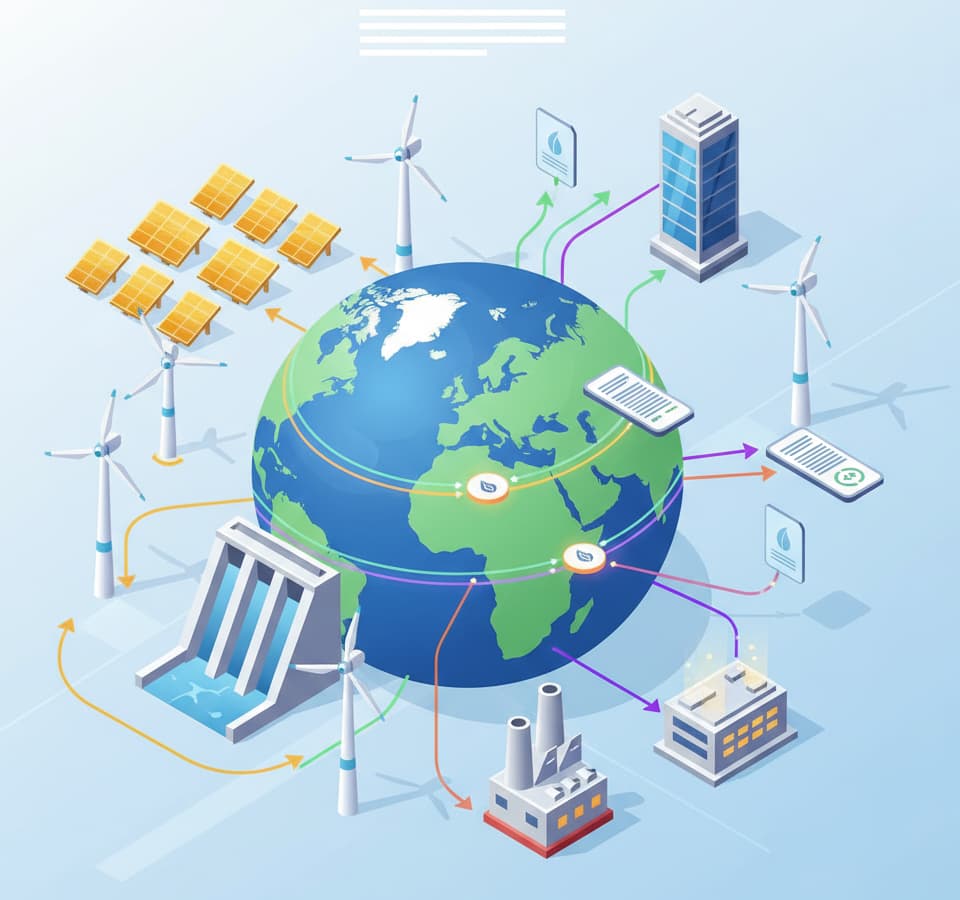I-RECs for Scope 2 Emissions: A Strategic Guide for Corporate Buyers

For multinational companies, Scope 2 emissions have become the litmus test of credible climate action. With regulators tightening disclosure rules, investors demanding transparency, and initiatives like RE100 setting the bar higher, International Renewable Energy Certificates (I-RECs) offer a globally recognized solution for addressing purchased electricity emissions in markets where direct procurement remains challenging.
The Scope 2 Imperative
Quick Reference: Scope 2 Basics
- What it covers: Indirect emissions from purchased electricity, heat, and steam
- Reporting methods: Location-based (grid average) vs. Market-based (specific purchases)
- The I-REC equation: 1 MWh of renewable energy = 1 I-REC certificate
Under the GHG Protocol's dual reporting framework, companies must navigate both location-based and market-based accounting. While location-based methods use regional grid averages, market-based accounting—where I-RECs play a crucial role—allows companies to claim specific renewable energy purchases. This distinction matters: without renewable energy certificates, even companies sourcing from green suppliers default to residual grid emissions in their market-based reporting.
Three Pillars of Strategic Value
Smart buyers recognize I-RECs deliver value across three critical dimensions:
1. Consistency Across Borders
I-RECs enable unified Scope 2 strategies in markets from São Paulo to Singapore. While European operations might leverage Guarantees of Origin and US facilities can access RECs, I-RECs fill the gap across Asia, Africa, and Latin America—covering over 50 countries where other instruments don't exist.
2. Compliance Without Complexity
Major reporting frameworks—CDP, SBTi, RE100—all recognize I-RECs for renewable electricity claims. As mandatory climate disclosures expand globally (think EU's CSRD or SEC climate rules), having established I-REC procurement processes positions companies ahead of regulatory curves.
3. Supply Chain Collaboration
Leading manufacturers increasingly require suppliers to demonstrate renewable energy use. I-RECs offer a practical tool for tier-2 and tier-3 suppliers in emerging markets to meet these demands, strengthening overall value chain resilience.
Smart Procurement: A Practical Playbook
The Four-Step Framework:
- Assess & Forecast: Map electricity consumption across all facilities. A consumer goods company with 20 factories across Southeast Asia discovered 30% variance between estimated and actual consumption—proper metering saved them $200,000 in avoided over-procurement.
- Match Strategically: Align certificate vintage with reporting years. Most standards accept certificates from the consumption year or up to 6 months after year-end for annual matching.
- Balance Your Portfolio: Mix premium certificates (Singapore solar at $8-12/MWh) for flagship facilities with cost-effective options (Indian wind at $0.50-1.50/MWh) for broader coverage.
- Document Everything: Maintain clear audit trails linking certificates to specific facilities and time periods—regulators and auditors increasingly scrutinize these claims.
Common Pitfalls to Avoid:
- Buying certificates from the wrong vintage year
- Ignoring local market regulations (some countries restrict I-REC exports)
- Over-purchasing based on outdated consumption data
- Focusing solely on price without considering reputational factors
Market Intelligence: Price Dynamics Decoded
I-REC markets operate on supply-demand fundamentals, but with regional quirks:
Premium Markets ($5-15/MWh)
- Singapore, Japan, South Korea: Limited renewable capacity, strong corporate demand
- Taiwan, UAE: Growing markets with increasing sophistication
Competitive Markets ($0.30-3/MWh)
- Brazil, Chile: Abundant hydro and wind resources
- India, China: Large renewable capacity, but watch for regulatory changes
- Turkey, South Africa: Emerging opportunities with good availability
Sophisticated buyers employ hedging strategies—locking in multi-year contracts when prices dip while maintaining flexibility for 20-30% spot purchases to capture market opportunities.
Real-World Example: A global technology firm saved 40% on their I-REC budget by securing three-year forward contracts for Indian wind certificates when prices temporarily dropped due to oversupply, while maintaining quarterly spot purchases for their dynamic Asian operations.
The Evolution Ahead
The GHG Protocol's ongoing revisions signal a shift toward more granular renewable energy claims. Today's annual matching might evolve into monthly or even hourly matching—similar to the 24/7 carbon-free energy movement gaining traction in advanced markets.
Forward-thinking companies are already preparing:
- Investing in better data systems to track hourly consumption patterns
- Exploring "Carbon-Free Energy Certificates" that provide time-stamped generation data
- Building relationships with renewable energy developers in key markets
The recent emphasis on "environmental attribute certificates" in SBTi's research suggests I-RECs will remain relevant but may require enhanced additionality demonstrations—proving that certificate purchases drive new renewable capacity rather than simply claiming existing generation.
Taking Strategic Action
I-RECs aren't a silver bullet for climate action, but for companies serious about credible Scope 2 management, they're an essential tool in the decarbonization toolkit. Success requires treating I-REC procurement as a strategic initiative—not a compliance checkbox.
Quick-Start Checklist:
- ✓ Audit current Scope 2 emissions across all operations
- ✓ Identify markets where I-RECs are the primary option
- ✓ Develop a procurement strategy balancing cost and credibility
- ✓ Establish systems for tracking and retirement
- ✓ Plan for evolving standards and increased granularity
Done right, I-RECs can deliver credible emissions reductions while managing costs effectively. The companies winning in this space are those that view I-REC procurement not as the end goal, but as a bridge to deeper renewable energy integration—using certificates strategically today while building toward direct procurement tomorrow.
